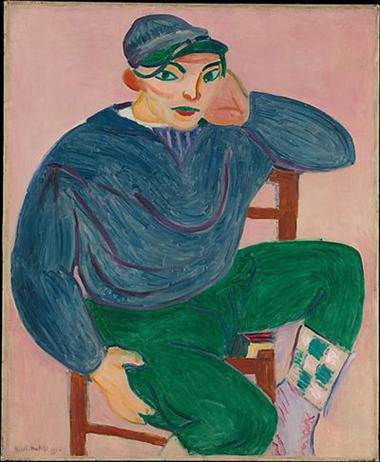
Henri Matisse (French, 1869–1954)
“The Young Sailor (Young Sailor II)“, 1906
Oil on canvas, 39 7/8 x 32 5/8 in. (101.3 x 82.9 cm)
Metropolitan Museum, New York
Jacques and Natasha Gelman Collection, 1998 (1999.363.41)
© 2011 Succession H. Matisse / Artists Rights Society (ARS), New York
Image from www.metmuseum.org
Matisse: In Search of True Painting The exhibition ‘Matisse: In Search of True Painting’ presents the particular aspects of Matisse’s painting process by showcasing 49 vibrantly colored canvases. Metropolitan Museum, December 4, 2012 — March 17, 2013.]]>
Source: Metropolitan Museum, New York
Henri Matisse (1869-1954) was one of the most acclaimed artists working in France during the first half of the 20th century. The critic Clement Greenberg, writing in The Nation in 1949, called him a “self-assured master who can no more help painting well than breathing.” Unbeknownst to many, painting had rarely come easily to Matisse. Throughout his career, he questioned, repainted, and reevaluated his work. He used his completed canvases as tools, repeating compositions in order to compare effects, gauge his progress, and, as he put it, “push further and deeper into true painting.” While this manner of working with pairs, trios, and series is certainly not unique to Matisse, his need to progress methodically from one painting to the next is striking.
Matisse copied old master paintings as part of his academic training. He found much to admire on the walls of the Musée du Louvre yet was also receptive to the contemporary pictures he encountered in Parisian galleries. He was particularly intrigued by the work of Paul Cézanne (1839-1906) and Paul Signac (1863-1935). Matisse borrowed stylistic elements from the two artists but was more interested in rendering his own sensations than subscribing to either of their theories.
Matisse’s stylistic exploration sparked the creation of pairs in which neither painting is entirely indebted to another artist. Upon his return to the fishing village of Collioure in the summer of 1906, he depicted a local teenager in a work that has all the hallmarks of his own vividly colored, expressive Fauvism (“Young Sailor I”, 1906, Collection of Sheldon H. Solow). He then painted a second version of the composition on an identically sized canvas, this time employing flat color and deformation to produce a drastically different effect (“Young Sailor II”, 1906, The Metropolitan Museum of Art). Unsure of his new direction, Matisse told friends that Young Sailor II had been painted by the local postman.
Over the next 10 years, Matisse approached his pairs in a variety of ways. He used a full-size cartoon and squaring to create his next major pair, life-size representations of a trio of nudes near the sea (“Le Luxe I”, 1907, Centre Pompidou, Musée National d’Art Moderne, Paris; and “Le Luxe II”, 1907-08, Statens Museum for Kunst, Copenhagen). Painting sessions with the sensual Italian model Laurette over a period of six or seven months in 1916-17 were instrumental in reorienting Matisse as he abandoned the restrictions inherent in painting in pairs and fully embraced larger series.
In the 1930s Matisse hired a photographer to document his progress on certain paintings. His model and studio assistant Lydia Delectorskaya recalled that the photographer was called in “when, at the end of a session, it seemed to Matisse he had come to the end of his work or he decided he had arrived at a significant stage….” In December 1945, six recent paintings by Matisse were displayed at the Galerie Maeght in Paris. Each was juxtaposed with large framed photographs documenting its evolution.
The theme of the studio interior —a consistent motif in Matisse’s oeuvre throughout his career—was addressed in Matisse’s final painted series, created from 1944 to 1948 at the Villa Le Rêve in Vence, France. The septuagenarian artist felt that a lifetime of work had prepared him to use color as a means of intimate expression. In the spring of 1948, he wrote to his son Pierre that his most recent paintings “impress everyone who has seen them because they are vivid and rich.” The critic Clement Greenberg was not alone in concluding that “Matisse is at the present moment painting as well as he ever has painted before, and in some respects perhaps, even better.”
Related content
NGA Australia acquires Matisse’s ‘Oceania, the sea’ (news, 2012)
Follow us on:


